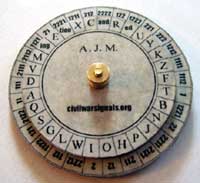Maybe this is what Carl Barks used to generate Beagle Boys numbers?
Maybe. It’s difficult to prove. That’s the problem with trying to figure out something like this. We can theorize till the cows come home, but how do we prove it?
Replying to my own comment; after doing some googling, I’m really starting to like the idea that it’s an old cipher disk with oqne or more disks missing, possibly from the civil war. Defensive indifference’s example and the Union disk linked below are both very reminiscent of our object.

Two more examples:
https://goo.gl/images/PMFNd7
https://goo.gl/images/vkjxVE
They are Albert Myer’s cipher disks.
My best guess if no one recognizes it is to move the inquiry to manufacture.
Tool marks? Maybe narrow down a time period or type of industry it came from.
Assembly method?
Fonts?
Shape of gear teeth?
Think of antiques road show. They get stuff unsigned or by unknown makers and can tell you where, when and for who a piece of furniture was made.
ROAD SHOW SPEECH:
“See here, these are handmade nails, as only south philly cabinet makers used in the 1850’s. The drawer pulls tell us he was taught in New York, and the unfinished underside tells us it was made for a retail store at the time.”
I don’t have an account on the Skeptics Forum linked in your OP. Did anyone over there figure it out?
I was thinking that someone at the National Cryptologic Museum might be able to say definitively. It might be worth reaching out to them, or a similar group.
I would question how robustly these things are made. A cipher disk wouldn’t need to be very strong or durable, but it looks like these things are.
Yeah, this thing looks like it would be a huge (possibly literal!) pain in the ass for a spy or scout to hide…
People didn’t agree with me years ago, I still think it is a gambling wheel, loosely based on common horse racing games. The permutation on the inner ring would be the odds multiplayer for a betting slot and the number on the outside would be the order of crossing the finish line.
IMHO this looks like a simplified trade simulator version of this far more complex game.
Like the man in the video mentions, in horse racing games there has to be odds, and the inner number probably related to that.
Compare it to another known example?
To further explain why this makes sense to me while noting I don’t have proof. It fits with the naming of “wheel” bets and wagering in horse racing and could function in a simplified fashion.
If it was, it was probably for a wager that would get you 1 to 3 cigars for your bet like many trade simulators.
Another video from a more complex device that shows how this worked.
trade stimulator, which my spell check does not like.
That’s a good point. And most of the examples I saw were made with card stock. But this one might have been intended for use onboard a ship or in a telegraph office or something. Then durability would be more important than concealment.
Thinking about it I should explain the game play that I would see working.
Customer comes in, places a bet for the price of a cigar, choosing a number 1 to 5. If the inner number is “win, place, and show” and the return multiplayer, a player would have a 60% chance at least leaving with a cigar, but a 40% chance of leaving with more than one cigar, but also a 40% chance of loosing the bet.
Where the pointer lands on the outer number is the “place” they got in the race, so if it lands on 4 or 5 they always loose.
Consider the numbers in the section in the image
132 : upper number
wps : position odds for “win, place show” or 1st, 2nd, 3rd place
Lower: 53214
If the pointer lands on:
1: 1 cigar, because of the #1 in the (w) win position
2: 3 cigars, second position § place
3: 2 cigars, third position (s) show
4: lose
5: lose
If the upper number was 213 like the next section, if the pointer lands on:
1: 2 cigars, because of the #2 in the (w) win position or the first digit in the upper number
2: 1 cigars, second position § place
3: 3 cigars, third position (s) show
4: lose
5: lose
I admit his is a pure guess, but it does fit known betting and business models.
Ooops, “choosing a number 1 to 5” should have been deleted, sorry but it was left over from a way too long post describing the more complex game.
No action except for a spin for this game and the odds for the player are:
20% of the time win 1x
20% of the time win 2x
20% of the time win 3x
40% of the time lose
A gambling game seems plausible to me. It somehow reminds me of the Chuck-a-Luck wheel I’ve seen at fundraising festivals (because Chuck-a-Luck with honest dice doesn’t have a big enough house edge, of course).
Its’ ttthe fabeld free-sided coin!

